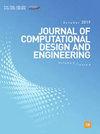基于数字游戏环境的四维空间时间解码与表示方法
IF 6.1
2区 工程技术
Q1 COMPUTER SCIENCE, INTERDISCIPLINARY APPLICATIONS
引用次数: 0
摘要
寻找新颖的表现方法是创意设计过程的关键组成部分之一。科学上的发现,如四维时空,影响了艺术家和建筑师。然而,现有的表示技术被限制在二维(2D)表中,用于表示4D时空,被评估为建筑学科的局限性。目前,数字游戏环境是4D建筑表现的潜在媒介。本研究旨在将时间解码并表示为4D空间的实体。数字游戏环境为在4D空间中进行实验提供了所需的灵活性。因此,unity游戏引擎和c#编程与计算机辅助设计(CAD)工具一起使用来生成4D表示。四维表示是基于时间维度的两种不同印象,即(1)时间膨胀和(2)时空扭曲。时间膨胀用运动模糊(mB)脚本表示,时空扭曲用运动轨迹(mT)脚本表示。作为初步结果,介绍了四维时空表示中时间维度的度量。本文介绍了通过Unity游戏引擎和c#编程生成的实验性4D表示,以讨论游戏环境作为建筑表示媒介的潜力。本文章由计算机程序翻译,如有差异,请以英文原文为准。
A Method for Decoding and Representing Time in Fourdimensional Spaces via Digital Game Environment
The search for novel representation method is one of the critical components of the creative design process. Discoveries in science, such as four-dimensional (4D) spacetime, influenced artists and architects. However, existing representation techniques constrained in two-dimensional (2D) sheets for 4D spacetime for representation is evaluated as a limitation of architecture discipline. Currently, digital game environments are the potential mediums of 4D architectural representation. This study aims to decode and represent time as an entity of 4D spaces. Digital game environment provides the needed flexibility for experimenting in 4D space. Therefore, unity game engine and C# programming are used together with computer aided design (CAD) tools to generate 4D representations. 4D representations are based on two different impressions of time dimension as (1) time dilation and (2) distortion of spacetime. While time dilation is represented via motion blur (mB) script, distortion of spacetime is represented via motion trail (mT) script. As preliminary results, metrics of the time dimension in 4D spatio-temporal representations are introduced. Experimental 4D representations produced via Unity game engine and C# programming are presented to discuss the potential of game environments to be the medium of architectural representation.
求助全文
通过发布文献求助,成功后即可免费获取论文全文。
去求助
来源期刊

Journal of Computational Design and Engineering
Computer Science-Human-Computer Interaction
CiteScore
7.70
自引率
20.40%
发文量
125
期刊介绍:
Journal of Computational Design and Engineering is an international journal that aims to provide academia and industry with a venue for rapid publication of research papers reporting innovative computational methods and applications to achieve a major breakthrough, practical improvements, and bold new research directions within a wide range of design and engineering:
• Theory and its progress in computational advancement for design and engineering
• Development of computational framework to support large scale design and engineering
• Interaction issues among human, designed artifacts, and systems
• Knowledge-intensive technologies for intelligent and sustainable systems
• Emerging technology and convergence of technology fields presented with convincing design examples
• Educational issues for academia, practitioners, and future generation
• Proposal on new research directions as well as survey and retrospectives on mature field.
 求助内容:
求助内容: 应助结果提醒方式:
应助结果提醒方式:


